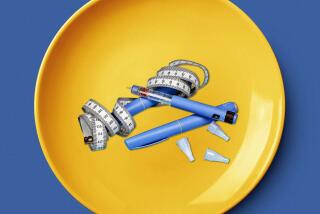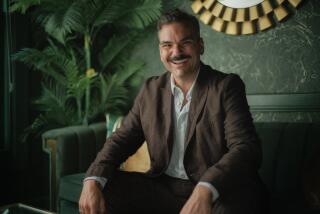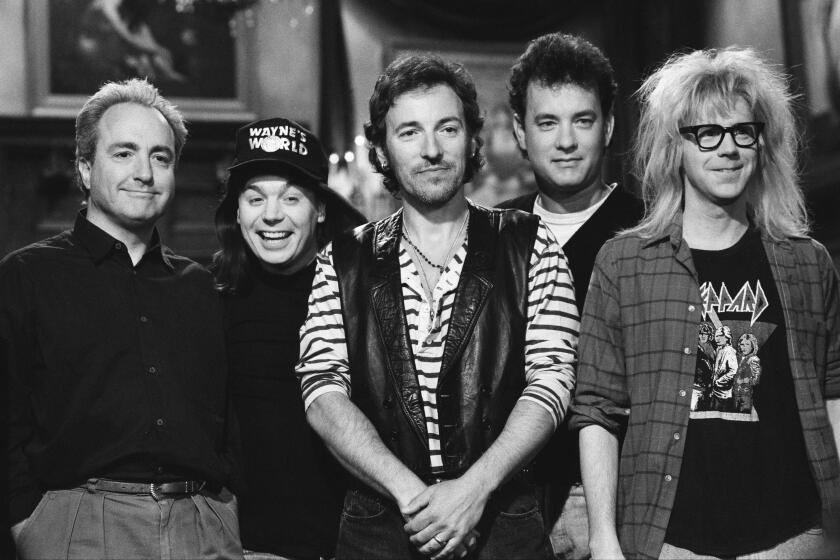Welcome to His ‘Zone’
- Share via
Barry Sears says he didn’t intend to become a diet guru when he wrote “The Zone: A Dietary Road Map” (HarperCollins/ReganBooks, 1995).
The 49-year-old biochemist, who holds 12 patents in the field of cancer therapy and spent four years at MIT doing research on viruses, lipids and nerve structure, wrote his book to alert medical professionals to the crisis he was witnessing in the health care field regarding obesity. Pages are filled with graphs and tables, scientific terms and mathematical calculations. To really understand Sears’ book you’d have to be a cardiovascular surgeon--but then heart specialists are exactly the audience Sears says he was trying to reach.
The general public, however, cut through the medical terminology to Sears’ core message: If people want to lose weight, enjoy optimal health and improve their athletic performance, they should avoid or restrict carbohydrates such as grains, pasta and bread and eat more protein and fat. The high-carbohydrate diet advocated by most medical professionals is causing Americans to gain weight, Sears maintains.
Madonna tried the diet, lost weight and credited Sears. So did a few Olympic athletes. Scores of yo-yo dieters found success with Sears’ plan as well. Even people who didn’t buy the book--including La Brea Bakery’s Nancy Silverton, who lost weight when she cut pasta and bread (her own baguettes included) out of her diet--started cutting carbohydrates as word of Sears’ eating plan spread.
“The Zone,” written with Bill Lawren, spent 45 weeks on the New York Times bestseller list. “Mastering the Zone: The Art of Achieving Super Health” (ReganBooks, 1997), targeting the general public and written with Mary Goodbody, sold more than a million copies during its first month in stores.
Naturally, Sears found himself in demand on the lecture circuit. Bookstores became venues for impromptu Zone lectures. In West Los Angeles, two of his seminars offered by the Learning Annex, in July 1996 and this January, were standing-room-only events, each attended by more than 400. Some of the more enthusiastic Zone followers have opened Zone centers around the country, offering personal training and advice as well as mail-order Zone meals and meal replacement bars--not always with Sears’ blessing.
One Zone lecturer in Los Angeles told me her claim to expertise was simply losing weight on Sears’ diet; she’d never met Sears. Another Zone lecture in Woodland Hills was given by a personal trainer who studied nutrition on his own but said he had met Sears, attended lectures and used the Zone on his clients with success.
When Los Angeles chef-restaurateur Jean Pierre Peiny lost 20 pounds in 1996 on the Zone, he created a Zone menu with input from Sears and launched it October at his restaurant, L.A. Farm, in Santa Monica. About 20% of the lunch orders are for the diet menu, Peiny said.
The Zone has definitely struck a chord among dieters, especially here in Southern California. “I have sort of a cult status in California,” Sears said during a phone interview from his office in Marblehead, Mass. And he’s still surprised by the enormous success of his books.
“That first book was written for cardiovascular physicians, not for the average person; it wasn’t an easy read,” Sears said. “You had to treat it like a college textbook. It was like working the New York Times Crossword Puzzle.”
In “The Zone” and “Mastering the Zone,” Sears advocates a diet composed of 40% carbohydrates, 30% protein and 30% fat. Such a distribution at each meal keeps the dieter in what he calls “the Zone,” a hormonally correct state in which insulin is in balance.
His premise is that the majority of Americans have a genetic defect that leads to overproduction of insulin. And carbohydrates trigger insulin release, which encourages the storage of fat.
By staying within “the Zone,” he maintains, people can lose weight and feel good. On the Zone program, no single meal should exceed 500 calories. (Sears suggests three meals and two snacks daily.) Sears also advises a combination of aerobic and weight-bearing exercise for 30 minutes five to six days a week.
Not everyone buys Sears’ message, however.
“There is no basis to Dr. Sears’ claim that 75% of Americans have a genetic defect that makes them fat when they eat carbohydrates,” said Chris Rosenbloom, an associate professor of nutrition and dietetics at Georgia State University and a nutrition consultant to the Georgia Tech Athletic Assn. “People lose weight using the Zone approach because it’s low in calories, not because it’s low in carbohydrates.”
“If a calorie is a calorie, then we’d all lose weight,” Sears responded. “I do my own studies. The data is out there. Let everyone read it and do their own. I know how this game [the pressures of publishing research and academic one-upmanship] is played.”
Many dietitians also complain that Zone dieters don’t get enough fiber when they cut so many carbohydrates from their diets.
“Zone dieters are not eating grains, but they are eating what their grandmothers told them,” Sears responded. “Fruits and vegetables. Apples, broccoli, kale, chard, spinach. Those are carbohydrates and full of fiber.”
“I don’t agree with everything Sears says,” said Evelyn Tribole, a dietitian in practice in Beverly Hills. “But he did get the attention of many of my fat-phobic clients to add a little bit more protein and fat to the diet.”
Sears is now concentrating on finishing a third book--this one on retarding the aging process through hormonal balance and blood testing--and gaining some control over the consequences of his celebrity status.
He is quick to insist, for instance, that he has no financial interest in the Zone centers and Zone-related food products that have emerged since the success of the first book.
“I am gratified that people use my name,” he said. “But there is widespread confusion in getting the message across. Hormonal control is a complex subject, and sometimes the message gets muted if the people spreading it don’t understand it.”
To remedy this, Sears and Dr. Paul Kahl, an associate of Sears and a medical doctor, have developed a training program that is being field-tested by dietitians, nurses and other medical professionals in Texas. The four-day intensive course will cost about $500 and require a final exam. Sears hopes to launch it in selected cities in September.
More to Read
Sign up for our Book Club newsletter
Get the latest news, events and more from the Los Angeles Times Book Club, and help us get L.A. reading and talking.
You may occasionally receive promotional content from the Los Angeles Times.








